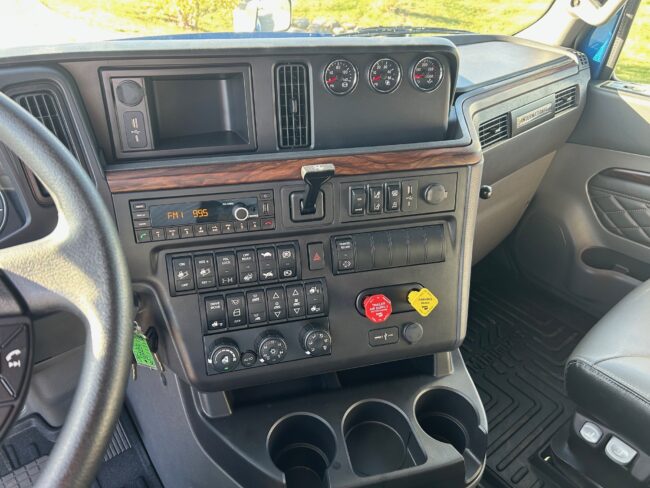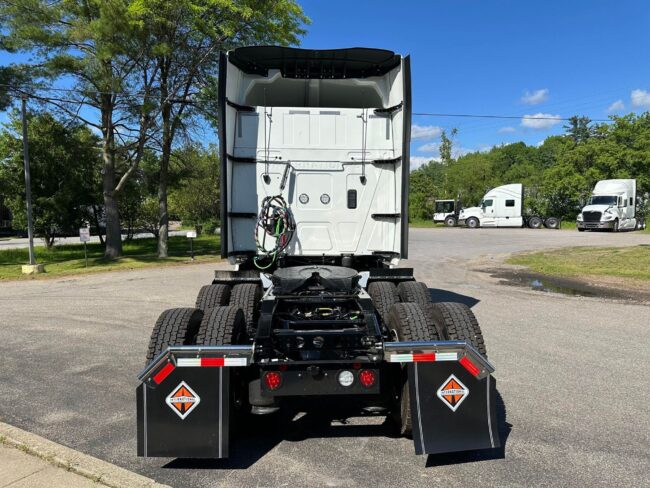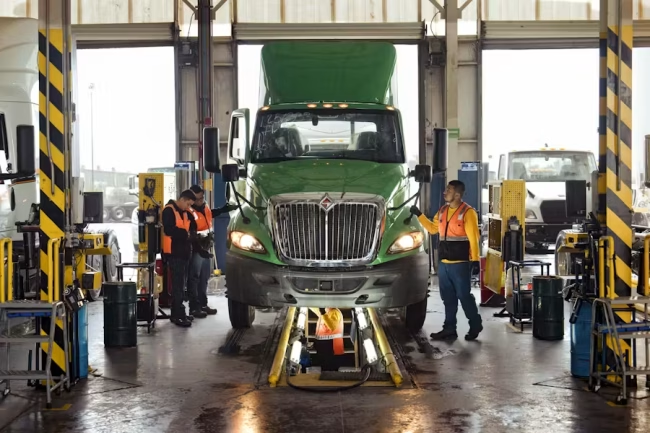From the first few kilometers, the 2025 International LT makes its intentions clear. It’s built to take on serious mileage – with the kind of engineering that rewards long hours, heavy loads, and precise driving.
International claims its latest LT combines improved aerodynamics, integrated powertrains, and driver-focused interiors to redefine long-haul performance. Those are big promises, especially in a class where reliability and comfort mean everything.
So, we took it through a week of mixed routes: steep climbs, crosswinds, and highway stretches with full trailers in tow. The goal? To find out whether the LT’s new design and engine lineup truly deliver measurable gains or if they just sound impressive on paper.
Quick Summary Table: Strengths vs Trade-offs
Here’s what stands out most clearly after the test miles:
| Strengths you’ll value | Trade-offs to watch |
| Excellent cabin comfort, reduced NVH (noise and vibration) | System complexity = more diagnostic vulnerability |
| Strong engine/transmission combinations, good torque curve | In very steep terrain at full load, margins shrink |
| Aerodynamic tuning that lowers drag and improves fuel use | Emissions and aftertreatment parts require strict upkeep |
| Wide safety and connectivity systems to ease driver workload | Remote part/service availability may lag in some areas |
1. Cabin Reality: Comfort, Functionality, and Long-Haul Habits

Step inside the LT’s cab and the priorities become obvious: visibility, quiet, space. The LT is offered in multiple sleeper and day cab variants – from the 56″ low-roof to the 73″ sky-rise sleeper – to fit tasks and crew setups.
- Materials are upgraded; seals, isolators, and interior insulation are tuned to reduce noise and vibration.
- Controls are placed with frequency in mind: the switches you touch most are just reachable, and the mirrors are mounted forward for minimized blind spots.
- Long runs confirm that the seats, bedding, and HVAC work in harmony – the cabin stops being something you tolerate and starts being a partner in fatigue.
- Storage is clever: overhead lockers, cargo bins, and useful cubbies without contorting your limbs.
After 600–800 km stretches, I felt less of that “truck-after-eight-hours” dragging in my bones.
2. Engine Lineup and Integrated Powertrains: Options, Torque, and Synergy
In 2025, the LT offers a choice between the International S13 integrated powertrain and the Cummins X15 engine.
- The S13 is a 12.74 L engine rated between 400 and 515 hp, with torque from 1,450 to 1,850 lb-ft.
- Cummins X15 can push further in some specs – up to 565 hp and higher torque ratings.
These pair with several transmission options – from the T14 automated manual, to Eaton Endurant variants, UltraShift, and other automatics/manuals.
What’s critical is how well they work as a system. On test units, I felt that the torque delivery is calibrated to match the transmission shifts cleanly – no glaring gaps, no hunting in moderate grades. The cooling, the turbo wastegate logic, aftertreatment systems all seem balanced.
However, complexity always brings fragility. Sensors, intricate wiring, and diagnostic modules can all become weak points over time. Out on remote stretches, a malfunction in the DEF system can turn into lost hours instead of minutes. That’s when having access to reliable DEF repair services makes a real difference – helping drivers quickly locate nearby repair shops and get back on the road with minimal downtime.
3. Towing Power and On-Road Behavior: Putting Muscle to Work

This is where the rubber (and freight) meets the road. Under heavy load conditions (e.g., 30+ ton trailer), the LT showed consistent pull-through climbs and passes.
- The S13 in its higher tune held speed on 4–5 % grades about as well as many class competitors.
- With the X15 in stronger spec, the reserve in torque becomes more evident during overtakes or steep inclines.
In passing tests (60 → 90 km/h loaded), times were solid, especially when the system held lower gears rather than hunting upward. Handling remains stable: brake blending, engine braking, and transmission downshifts combine to hold control in downhill runs.
Crosswind stability benefits from the LT’s cab shape and skirts/deflectors. Fuel economy in highway runs proved competitive, particularly when the aero package was matched with judicious throttle use.
| Metric | Observed Behavior |
| Climb speed on a 4–5 % grade | Maintained mid-60s to low-70s km/h before the shift |
| Passing (60 → 90 km/h loaded) | Smooth, strong reserve torque |
| Handling/crosswind feel | Stable, neutral steering |
| Combined econ (with aero aid) | Competitive among class benchmarks |
Even under long hours and varied unloading, I detected no major thermal or performance drop-offs – a sign of good design margins.
4. Reliability, Maintenance, and Real-World Risks

High complexity means vigilance. I observed that the LT’s diagnostic net is deep — an alert or sensor misread can force limp mode or flag warnings. That’s not inherently bad — better to warn early than fail late — but it means preventive upkeep is critical.
Regular DEF system checks, sensor calibrations, wiring harness checks, and module firmware integrity will keep things stable. Parts availability, especially in remote regions, may lag behind older or more common models, so thoughtful logistics planning is essential.
Emissions systems (DPF, SCR, etc.) are standard practice today, but must be disciplined in service regimes.
Did you know? International claims that the S13 package reduces the need for EGR coolers by simplifying exhaust routing, thus trimming some maintenance complexity. That design choice aims to make long-haul life simpler — but even then, any system with many calibration points demands respect.
Conclusion and Verdict
After extensive highway runs, loaded climbs, and day-to-night hauls, the 2025 International LT proves to be far more than a routine model update. It’s a long-haul machine that blends efficiency, comfort, and control into one well-tuned package. The engine options give fleets flexibility, the aerodynamics save real fuel, and the cabin finally feels like a space designed with drivers, not accountants, in mind.
It isn’t flawless, complexity brings more components to watch, and remote servicing can still challenge operators, but that’s the trade-off for running at the cutting edge of modern trucking. What stands out is how composed and consistent the LT feels after thousands of kilometers. It inspires confidence mile after mile, without demanding constant corrections or compromises.
For professional drivers who measure a truck by how it behaves at hour twelve, not hour one, the International LT 2025 delivers what truly matters: endurance, predictability, and a cabin that feels like home even when you’re a thousand miles from it.



